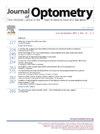Insights into burnout among optometrists in the United States: findings from a nationwide survey
IF 1.8
Q2 OPHTHALMOLOGY
引用次数: 0
Abstract
Purpose
To determine the prevalence of burnout among optometrists in the United States and identify associated demographic and clinical factors.
Methods
A survey was distributed to optometrists via email listservs from the American Academy of Optometry and optometric societies. Participants completed a modified Mini Z Survey with 10 questions rated on Likert scale, followed by demographic questions. Burnout was classified as mild, moderate, or severe, with subgroup comparisons made using multinomial logistic regression.
Results
1436 optometrists responded. 53.6 % of respondents reported symptoms of burnout: 61.4 % mild, 30.4 % moderate, and 8.2 % severe. Females reported higher burnout rates than males (60.9 % vs. 40.6 %, p < 0.0001). Optometrists with a spouse/partner in healthcare reported lower burnout (47.7 %) compared to those without (55.3 %, p = 0.0035). Respondents with children reported less burnout (49.6 % vs. 61.0 %, p < 0.0001). Burnout was less prevalent among those practicing <5 years (51.1 %) and 30+ years (33.7 %) compared to mid-career (5–29 years). Average number of clinic days was associated with burnout severity. Electronic health record (EHR) use was associated with higher rates of burnout (p = 0.0040). Respondents in private practice and academic settings reported the lowest burnout rates.
Conclusions
Burnout is a significant concern among U.S. optometrists, with female optometrists disproportionately affected. Protective factors include male gender, having children, both shorter and longer commutes, and specific work settings. Risk factors include female gender, increased clinic days, higher patient volume, and EHR use. Future research should focus on longitudinal studies of burnout, intervention-based studies to evaluate mitigation strategies, and qualitative research to explore gender differences and work-related stressors in optometry.
对美国验光师职业倦怠的洞察:一项全国性调查的结果
目的 确定美国验光师职业倦怠的发生率,并找出相关的人口和临床因素。方法 通过美国验光学会和验光协会的电子邮件列表向验光师发放调查问卷。参与者填写了一份经修改的迷你 Z 调查表,其中包括 10 个以李克特量表评分的问题,然后是人口统计学问题。职业倦怠分为轻度、中度和重度,采用多项式逻辑回归法进行亚组比较。53.6%的受访者报告了职业倦怠症状:61.4%为轻度,30.4%为中度,8.2%为重度。女性报告的职业倦怠率高于男性(60.9% 对 40.6%,p < 0.0001)。有配偶/伴侣从事医疗保健工作的验光师报告的职业倦怠率(47.7%)低于没有配偶/伴侣的验光师(55.3%,p = 0.0035)。有子女的受访者倦怠感较低(49.6% 对 61.0%,p = 0.0001)。与职业生涯中期(5-29 年)相比,职业倦怠在从业 5 年(51.1%)和 30 年以上(33.7%)的受访者中发生率较低。平均门诊天数与职业倦怠的严重程度有关。电子健康记录(EHR)的使用与较高的职业倦怠率相关(p = 0.0040)。结论职业倦怠是美国验光师的一个重要问题,女性验光师受到的影响更大。保护因素包括男性性别、有子女、通勤时间较短和较长、特定的工作环境。风险因素包括女性性别、门诊天数增加、患者量增加以及电子病历的使用。未来的研究应重点关注职业倦怠的纵向研究、评估缓解策略的干预性研究,以及探索验光师性别差异和工作压力的定性研究。
本文章由计算机程序翻译,如有差异,请以英文原文为准。
求助全文
约1分钟内获得全文
求助全文

 求助内容:
求助内容: 应助结果提醒方式:
应助结果提醒方式:


